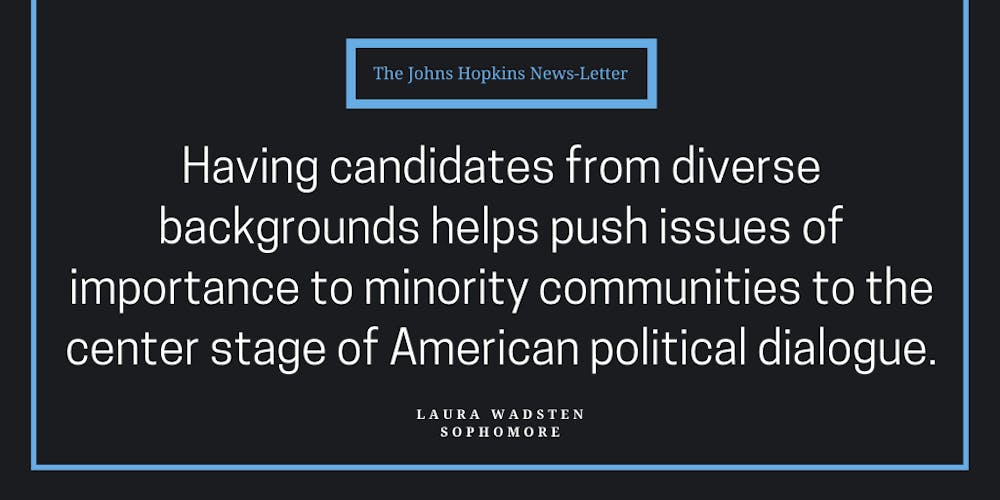With Tom Steyer, former Mayor Pete Buttigieg, Senator Amy Klobuchar and former Mayor Mike Bloomberg dropping out of the race for the Democratic nomination, the field now has even less diversity than it did last week. Now that my preferred candidate is no longer in the running, I’m tasked with selecting a new candidate.
As if that wasn’t hard enough the first time, the field is now much smaller and less diverse. The leading candidates are overwhelmingly old, male and exclusively white. To put it in perspective: two out of the top three candidates are white men in their late seventies.
In 2008, the U.S. elected Barack Obama, the first black president. In 2016, Hillary Clinton was the first female presidential candidate to represent a major party.
Now it’s 2020. Every day, it seems more and more likely that we’ll be choosing between two old white men in November.
I am not trying to say old white men are evil — there are some really important old white men in my life. I also do not intend to suggest that any candidate should be discounted for their age, race, sex or any other factor outside of their control. Additionally, non-minority candidates can make a difference in minority communities, especially if they make the conscious choice to listen to constituents and be informed allies.
All I’m saying is that I’m disappointed in how homogenous the remaining field of Democratic candidates is.
How did we get here? Throughout this excruciatingly long campaign cycle, the Democratic Party had the most diverse assemblage of presidential candidates in United States history.
Multiple people of color were present on the early debate stage. Well-known politicians like Kamala Harris and Cory Booker stood next to newbie underdogs like Andrew Yang. As an NBC News opinion piece from last summer noted, only five female candidates had ever appeared in a U.S. presidential debate before 2019. In this campaign cycle, six women debated on national television. Buttigieg was the first openly gay presidential candidate, and the first serious Millennial candidate.
Somehow, over the course of past year, the encouragingly diverse field of presidential prospects has shriveled to a relatively uniform lineup.
It matters that the candidates for the highest office in our government are diverse, and not just because of the value of representation. Yes, it would mean a lot to me if the national leader was referred to as “Madame President,” but there’s much more than that at stake.
Having candidates from diverse backgrounds helps push issues of importance to minority communities to the center stage of American political dialogue.
Though some lawmakers have worked for decades to get the U.S. government to consider reparations for slavery, this election cycle brought this issue to the forefront. Reparations likely came up in a nationally televised debate at least in part because of the presence of candidates of color, including Booker, who sponsored a bill in the Senate to study reparations.
In more than one debate this cycle, female candidates pushed for greater recognition of issues that affect women, like the wage gap and reproductive rights.
This is not to say that minority candidates should bear the responsibility of making Americans think about these issues. It is the duty of every candidate to make policies that are conscious of the effects of discrimination and systemic oppression in our society.
In most situations, however, the person best able to speak to an issue is someone who has experienced it. In order to best address issues relevant to diverse groups within our country, we need to have diverse perspectives making the decisions.
It is too late to change who the top candidates of 2020 are now, but that doesn’t mean there is nothing to be done about a lack of diversity among presidential candidates. The current primary and caucus calendar gives disproportionate importance to the state of Iowa, which is 85.3 percent non-Latino white.
If the entire country held primaries on the same day, candidates of diverse backgrounds would have a fairer chance of securing the nomination. On an individual level, we must make a conscious effort to support diverse candidates, and encourage people from diverse backgrounds to run.
I’m committed to voting for the Democratic nominee in 2020. But I’m much less inspired to cast my first presidential ballot for a candidate like Joe Biden than I would have been to cast it for someone with a different perspective to offer. The disappointingly homogeneous field of candidates should motivate us to take the necessary steps to encourage and support future presidential candidates of diverse backgrounds.
Laura Wadsten is a sophomore studying International Studies and Medicine, Science and the Humanities from Brainerd, Minnesota. She is a Science and Technology Editor and a member of Hopkins Democrats.

















